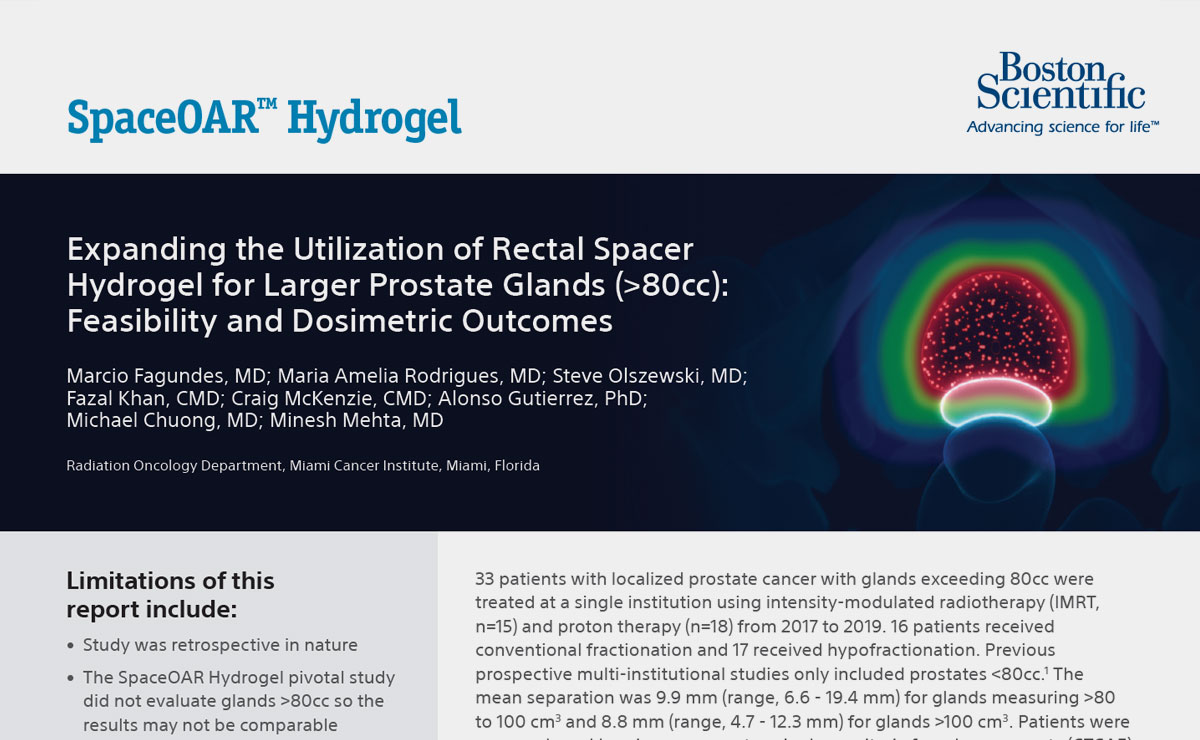Boston Scientific accounts are for healthcare professionals only.
Editorial commentary
In my practice perirectal spacers can be an important tool to reduce the radiation dose to the anterior rectal wall during radiation treatment for prostate cancer.1–3 Specifically, the SpaceOAR Hydrogel has been clinically shown to help minimize urinary, sexual, and bowel side effects and help protect the quality of life for my prostate cancer patients undergoing radiation therapy.1–3 While these perirectal spacers are important to my patient outcomes, hydrodissection is a critical first step to ensure the needle is in the proper space during a spacer placement procedure.4
Hydrodissection uses injectable saline to open the perirectal space.4 Because the needle injecting the saline is being placed between millimeter thick layers, it can sometimes be either too high in the periprostatic fascia or too low in the top layers of the rectal wall. Hydrodissection provides the necessary security of knowing you are, in fact, in the correct space.4 It can allow physicians to visualize where the spacer will be injected and confirm symmetry within this space.
It’s important to note that the perirectal space may not open during hydrodissection, perhaps due to scar tissue. If this space does not open with saline, the SpaceOAR Hydrogel should not be injected.4 Ultimately, hydrodissection allows physicians to evaluate whether to move forward with a spacer or to abort the procedure should there be significant issues observed based off the nature of the saline.4
The hydrodissection procedure
The first step I take during hydrodissection is to make sure the needle is in the perirectal space. This reduces the chance of hydrodissecting an incorrect space, such as the outer layers of the rectal wall or rectal prostatic fascia. Proper needle placement ensures that the opening created with the saline injection is between the prostate and rectal wall, thus allowing accurate placement — and eventual dissipation — of the hydrogel spacer.
The process of hydrodissection starts at mid-gland, from base to apex, and midline. For proper visualization, the ultrasound probe is lowered, parallel to the floor. This will create a separation or decompression without being too anterior, which could result in compressing the prostate and limiting how much space is created. Proper probe positioning will also ensure that the perirectal fat plane is not compressed, and that the hydrogel is properly placed given that the gel tends to follow the path of least resistance.
Placing the needle at midline, or mid-gland sagitally, the saline should dissipate symmetrically as much as possible, from left to right during the hydrodissection, thus signaling a proper hydrogel placement.
Patients with scarring
During my hydrodissection procedures, scarring may be observed in patients who have had prior biopsies, cryotherapy, high-intensity focused ultrasound (HIFU) or other treatments for a known infection. Scarring may also be observed in patients with prostatitis, chronic prostatitis and sometimes more common conditions, such as hemorrhoids. In these cases, hydrodissection is extremely valuable as it can confirm if the area of the prostate rectal interface will open enough to place a spacer. Given that scarring may limit separation in some patients, it’s important to proceed gently.4
When scarring is identified, the needle should be positioned away from the scar tissue. For example, if a patient has been treated with HIFU or cryotherapy and the lateral left aspect of the prostate is retracted and scarred, the needle should be placed at the patient midline or slightly to the contralateral side — the unaffected side — to determine if it opens. If it does, gently pull back the needle and reposition it toward the side that was not opening, at midline or just over, to determine if it will open. If perirectal space does not open with saline, do not inject the SpaceOAR. If much of the space opens, it’s possible to consider placing the hydrogel spacer, recognizing that the opening may be limited.
Gauging resistance
Sometimes I notice resistance when attempting to inject the saline. This is usually a result of scar tissue or improper needle placement, such as the needle being placed in the fascia or the rectal wall. It’s important to review your patient’s medical history in advance to identify if scarring may be present and look closely at the anatomy when noticing resistance. When no scarring is present and the needle is positioned correctly, there is little to no resistance and the space will open relatively easily. Recognizing this resistance and identifying its cause becomes easier with time and experience.
Rectal wall and key anatomy
There are ways I visually confirm proper opening and ensure the needle is not placed in the rectal wall. The physician should see a dark water-like ultrasound signal that opens and closes as the saline dissipates from the perirectal fat plane. Proper hydrodissection should have a breathing effect rather than pooling effect.
The dark signal visible on the ultrasound should appear to be pushing the rectal wall away, as opposed to permeating it. This indicates that the needle is in the appropriate space. Visibly, the needle should be distinct from the rectal wall and if it’s not, this is a sign that it may have been inadvertently placed in the rectal wall. In this situation, there is a grayish pooling signal permeating the rectal wall rather than the dark water-like signal. This requires adjusting the needle, which may be too posterior.
Proper needle placement and avoiding the fascia and rectal wall on either side is critical to the ultrasound image quality and anatomy recognition. Ideally, this position is just off the prosthetic fascia in the perirectal space. The fascia must be visible as it comes off the apex and goes under the prostate toward the base. At no point during the insertion should the rectal wall or any of its layers be penetrated, which would split the wall layers open.
Another option to confirm proper needle placement is by reviewing the axial view on the ultrasound by moving the probe back until just the very tip of the needle is visible.4 Then gently adjust the needle — anterior to posterior only — by about two millimeters. It’s important not to move the needle sideways, from left to right. When making this slight anterior to posterior adjustment, the needle can sometimes be seen dragging the rectal wall which would be a signal that the needle would need to be repositioned. However, if the needle has penetrated the rectal wall at the apex, or entrance, it may not be visible on the axial view due to it being lower at the entrance or apex level.
Conclusion
In my practice, hydrodissection is an imperative and effective portion of any perirectal spacing procedure, providing the placing physician with security and confidence that a spacing product is being placed in the correct space. It helps ensure proper needle placement when creating an opening in the perirectal space, and confirm symmetry and safe needle positioning while allowing the placing physician the ability to visualize the anatomy where the spacer will be injected.4 Proper placement of any perirectal spacer must start with this critical step, which may potentially lead to safer and more effective patient outcomes during radiotherapy treatment.
Related content
References
- Hamstra DA, Mariados N, Sylvester J, et al. Continued benefit to rectal separation for prostate radiation therapy: final results of a phase III trial. Int J Radiat Oncol Biol Phys. 2017;97:976–985.
- Hamstra DA, Mariados N, Sylvester J, et al. Sexual quality of life following prostate intensity modulated radiation therapy (IMRT) with a rectal/prostate spacer: secondary analysis of a phase 3 trial. Pract Radiat Oncol. 2018;8:e7–e15.
- Mariados N, Sylvester J, Shah D, et al. Hydrogel spacer prospective multicenter randomized controlled pivotal trial: dosimetric and clinical effects of perirectal spacer application in men undergoing prostate image guided intensity modulated radiation therapy. Int J Radiat Oncol Biol Phys. 2015;92:971–977.
- Data on file with Boston Scientific.
Marcio Fagundes, M.D., is a Boston Scientific consultant and was compensated for his contribution to this editorial. Statements made in this editorial represent the experience of Dr. Fagundes. Patient responses can and do vary.
Results from case studies are not necessarily predictive of results in other cases. Results in other cases may vary.
Caution: U.S. Federal law restricts this device to sale by or on the order of a physician.
IMPORTANT INFORMATION: These materials are intended to describe common clinical considerations and procedural steps for the use of referenced technologies but may not be appropriate for every patient or case. Decisions surrounding patient care depend on the physician’s professional judgment in consideration of all available information for the individual case.
Boston Scientific (BSC) does not promote or encourage the use of its devices outside their approved labeling. Case studies are not necessarily representative of clinical outcomes in all cases as individual results may vary.
Results from different clinical investigations are not directly comparable. Information provided for educational purposes only.
For information purposes only. The content of this article/publication is under the sole responsibility of its author/publisher and does not represent the opinion of Boston Scientific.
All images are the property of Boston Scientific. All trademarks are the property of their respective owners.

